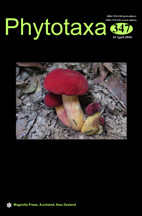Abstract
A fungal disease with aerial-root-liked gall symptoms on Cinnamomum subavenium in Khao Yai National Park, Northeastern Thailand is reported, and the causative agent identified as Laurobasidium hachijoense. Cultures from the Thai specimens, as well as the type culture from Japan, were sequenced for LSU and ITS genes. Analysis of these gene sequences showed that the Thai isolates clustered with the type strain of Laurobasidium hachijoense. This is the first report of this fungus on a new host and in Thailand. Morphology of this fungus from the Thai specimens as well as the seasonal symptom in the natural forest are described and illustrated. Laurobasidiaceae is proposed as a new family for Laurobasidium. It was nested in a highly supported clade with the Cryptobasidiaceae and a sister clade to the Branchybasidiaceae, Graphoilaceae and Exobasidiaceae clades within the order Exobasidiales. Laurobasidiaceae morphologically possesses basidial sterigmata, thin-walled basidiospores with an abaxial hilum, and sporulating on the surface of the host tissues. It is unique from other families in the Exobasidiales in causing aerial-root-like galls on the host plant. The phylogenetic analysis revealed that strains of Acaromyces ingoldii grouped together with Laurobasidium hachijoense indicating they are conspecific. Morphological examination also confirmed that these two taxa are the same fungus. Laurobasidium hachijoense is proposed as the valid name based on its occupation of the initial type material of this organism, and the monotypic genus Acaromyces becomes a synonym of Laurobasidium. Exobasidium cinnamomi is also considered a Laurobasidium species based on its morphology and the stag-horn-like galls on a lauraceous host. The taxonomy of the Laurobasidiaceae is discussed.

